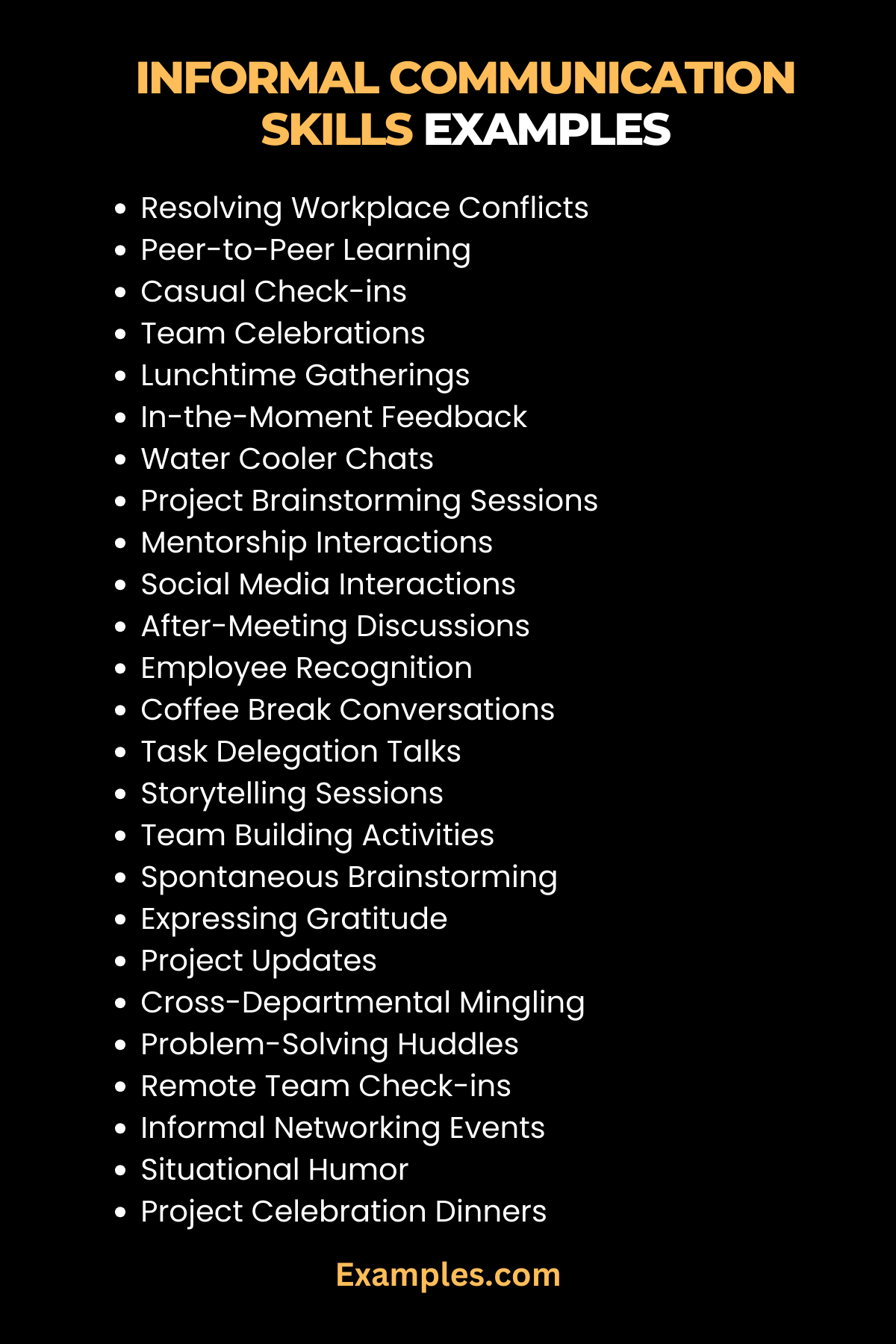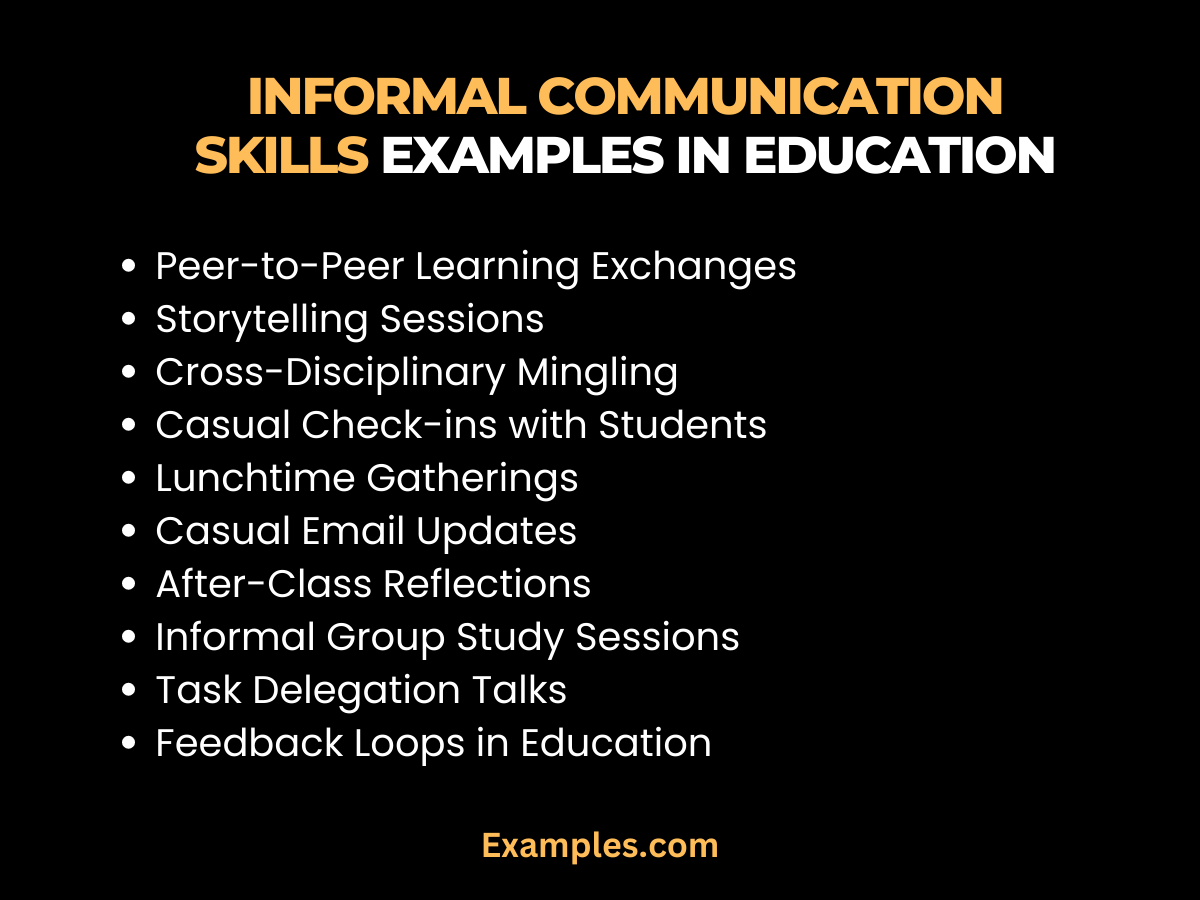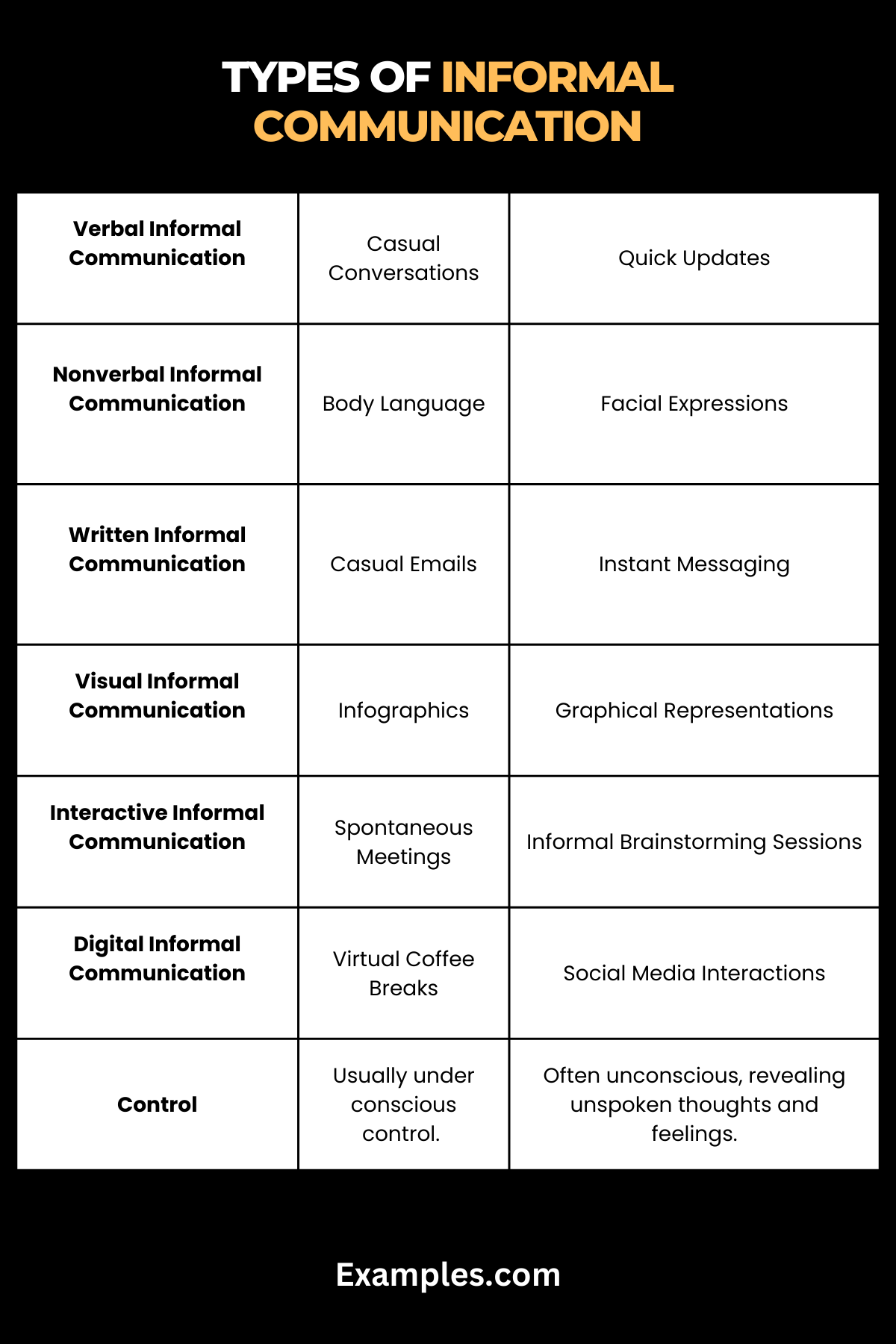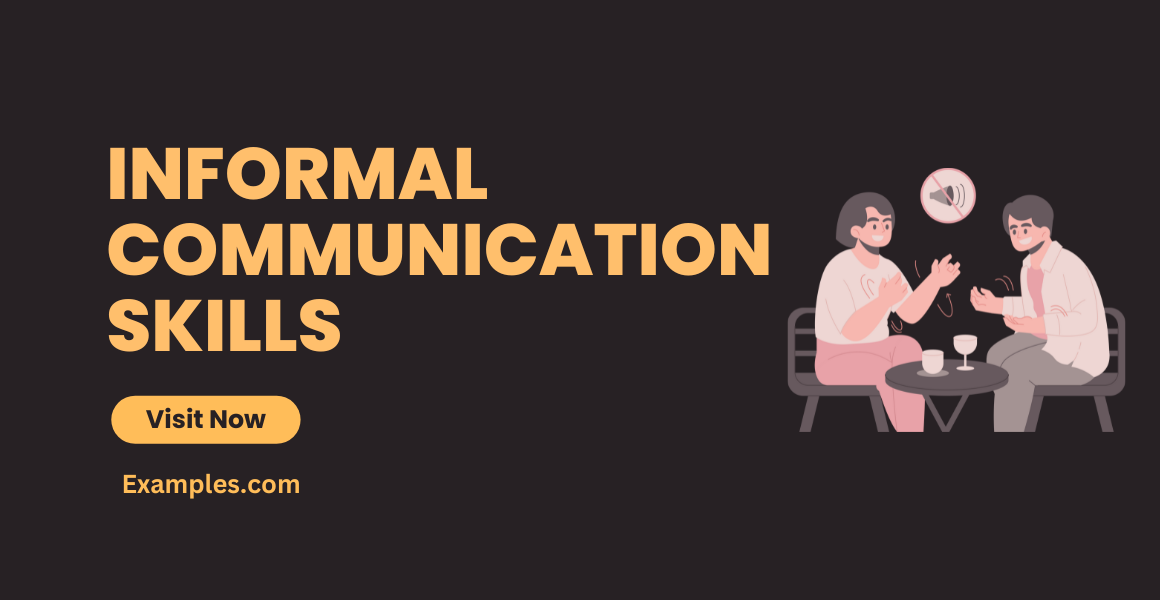29+ Informal Communication Skills Examples
Informal communication, a dynamic facet of human interaction, manifests in various forms across different settings. This comprehensive guide categorizes and elucidates the diverse types of informal communication through a structured table. Each type, from casual conversations to unplanned video calls, is meticulously outlined, shedding light on its defining characteristics, applications, and impact on fostering effective communication. Delve into this resource to gain a nuanced understanding of the rich tapestry of informal communication types, empowering you to navigate interpersonal dynamics with finesse
What is Informal Communication Skills?
Informal communication skills refer to the spontaneous, unstructured interactions that occur outside formal channels. In simple terms, it’s the natural way we communicate in everyday situations, such as chatting with colleagues, classmates, or in health settings. This form of communication is vital for building relationships and fostering a positive atmosphere. Explore the essence of informal communication skills as we break down the definition into clear, straightforward insights
What is the best Example of Informal Communication Skills?
In the bustling workplace, a stellar example of informal communication skills often surfaces in spontaneous problem-solving sessions. Picture this: a team faced with an unexpected challenge gathers informally, exchanging ideas freely. The beauty lies in the fluidity and directness of communication—no rigid protocols. This open dialogue fosters creativity, synergy, and swift resolution. Such instances epitomize the power of informal communication in navigating complexities and achieving collective success.
30 Informal Communication Skills Examples
Dive into a comprehensive exploration of 30 vivid examples showcasing the artistry of informal communication skills. From workplace dynamics to educational settings and healthcare interactions, this compilation unveils the versatility of effective communication. Now, let’s delve into a selection of 100 unique, distinct, and best examples, each accompanied by two lines of explanation to guide you on mastering the nuances of informal communication.

- Resolving Workplace Conflicts: Addressing issues openly encourages collaboration and strengthens team bonds.
- Peer-to-Peer Learning: Sharing insights informally fosters a culture of continuous learning and knowledge exchange.
- Casual Check-ins: A quick, informal chat can build rapport and maintain strong professional relationships.
- Team Celebrations: Informally recognizing achievements enhances morale and reinforces a positive work environment.
- Lunchtime Gatherings: Casual conversations over meals create opportunities for team bonding and stress relief.
- In-the-Moment Feedback: Timely, informal feedback fosters continuous improvement and personal development.
- Water Cooler Chats: Spontaneous discussions at the water cooler encourage a friendly and open workplace culture.
- Project Brainstorming Sessions: Informal brainstorming sparks creativity and generates innovative solutions for challenges.
- Mentorship Interactions: Casual discussions with mentors provide valuable insights and guidance for professional growth.
- Social Media Interactions: Engaging in casual conversations on social platforms strengthens online connections and networks.
- After-Meeting Discussions: Informal post-meeting chats clarify doubts and ensure everyone is on the same page.
- Employee Recognition: Expressing appreciation informally motivates team members and boosts overall morale.
- Coffee Break Conversations: Brief coffee breaks offer opportunities for impromptu discussions and relationship building.
- Task Delegation Talks: Informal communication eases the process of assigning tasks and clarifying expectations.
- Storytelling Sessions: Sharing anecdotes and stories informally fosters a sense of community and shared experiences.
- Team Building Activities: Participating in informal team-building activities strengthens collaboration and camaraderie.
- Spontaneous Brainstorming: Unplanned idea generation sessions encourage free-flowing creativity.
- Expressing Gratitude: Informally thanking colleagues promotes a positive and appreciative workplace culture.
- Project Updates: Quick, informal updates on project status ensure everyone stays well-informed.
- Cross-Departmental Mingling: Informal interactions between different departments break down silos and improve overall communication.
- Problem-Solving Huddles: Gathering informally to tackle challenges collectively leads to effective solutions.
- Remote Team Check-ins: Informal virtual meetings maintain connections among remote team members.
- Informal Networking Events: Casual networking fosters professional relationships and opens doors to new opportunities.
- Situational Humor: Appropriate humor in informal conversations lightens the mood and builds a positive atmosphere.
- Project Celebration Dinners: Marking project milestones with informal celebrations boosts team spirit.
- Post-Event Reflections: Informal discussions after events provide insights for future improvements.
- Feedback Loops: Regular, informal feedback loops ensure continuous improvement in work processes.
- Casual Email Updates: Brief email updates keep team members informed without formalities.
- Spontaneous Video Calls: Unplanned video calls foster a sense of connection and bridge communication gaps.
- Task Progress Snapshots: Sharing quick progress snapshots informally ensures transparency and keeps everyone updated.
Informal Communication Skills Examples in Workplace
Navigate the intricacies of workplace interactions with these vivid examples of informal communication skills. From quick problem-solving huddles to spontaneous project celebrations, discover how informal communication fosters collaboration, creativity, and a positive work culture. Elevate your workplace communication game with real-world scenarios and actionable insights.
- Coffee Break Connections: Casual chats over coffee build camaraderie and strengthen team bonds.
- Walking Meeting Wisdom: Conducting meetings on the move encourages relaxed yet productive discussions.
- Task Progress Snapshots: Quick progress snapshots shared informally ensure transparent and efficient project tracking.
- Post-Event Reflections: Informal discussions after events provide valuable insights for future improvements.
- Situational Humor Harmony: Appropriate humor lightens the mood, fostering a positive and collaborative atmosphere.
- Remote Team Coffee Hours: Informal virtual coffee hours maintain connections among remote team members.
- Project Update Briefs: Sharing quick project updates informally keeps everyone well-informed.
- Impromptu Brainstorming Sessions: Spontaneous idea generation encourages creativity and innovation.
- In-the-Moment Feedback: Timely, informal feedback sessions foster continuous improvement and personal development.
- Casual Recognition Rituals: Expressing appreciation informally boosts morale and strengthens team spirit.
Informal Communication Skills Examples in Education
Explore the realm of informal communication skills in education, where peer-to-peer learning, storytelling sessions, and cross-disciplinary mingling shape a dynamic learning environment. These examples showcase the power of informal communication in fostering collaboration, knowledge exchange, and student engagement.

- Peer-to-Peer Learning Exchanges: Informal knowledge-sharing sessions among students foster a culture of continuous learning.
- Storytelling Sessions: Sharing anecdotes and stories informally creates a sense of community and shared experiences.
- Cross-Disciplinary Mingling: Informal interactions between different disciplines broaden perspectives and enhance learning.
- Casual Check-ins with Students: Quick, informal check-ins with students create opportunities for personalized support.
- Lunchtime Gatherings: Informal discussions over meals encourage open dialogue and strengthen student-teacher relationships.
- Casual Email Updates: Brief email updates keep students informed about important academic information.
- After-Class Reflections: Informal discussions after classes provide additional insights and clarify doubts.
- Informal Group Study Sessions: Spontaneous study sessions encourage collaborative learning and knowledge exchange.
- Task Delegation Talks: Informal communication eases the process of assigning group projects and clarifying expectations.
- Feedback Loops in Education: Regular, informal feedback loops ensure continuous improvement in teaching methods.
Informal Communication Skills Examples in Health and Social Care
In health and social care, informal communication skills play a crucial role in building trust, providing empathetic care, and enhancing overall patient well-being. Explore these examples, from therapeutic communication to post-care reflections, that highlight the importance of informal communication in healthcare settings.
- Therapeutic Communication Moments: Informal dialogues with patients create a nurturing and supportive healthcare environment.
- Casual Check-ins with Patients: Quick, informal check-ins with patients promote a patient-centered approach and show genuine care.
- Post-Care Reflections: Informal discussions after providing care offer insights for continuous improvement in patient support.
- Empathetic Communication Practices: Expressing empathy informally fosters trust and strengthens the patient-caregiver relationship.
- Casual Team Huddles: Spontaneous team huddles provide a platform for quick updates and collaborative problem-solving.
- Visual Communication Techniques: Incorporating visual aids in informal communication enhances understanding and patient engagement.
- Casual Support Group Sessions: Informal group sessions create a sense of community and emotional support among patients.
- Lunchtime Well-Being Talks: Informal well-being discussions during breaks contribute to a positive and supportive healthcare culture.
- Post-Visit Follow-Ups: Informal follow-ups with patients ensure continued care and address any concerns or questions.
- Casual Recognition of Caregivers: Expressing appreciation informally boosts morale and fosters a supportive caregiving environment
What is a Characteristic of Informal Communication?
Informal communication is marked by distinctive features that set it apart from formal channels. Explore the key characteristics that define the essence of informal communication:
1. Spontaneity and Flexibility:
- Informal communication thrives on spontaneity, allowing for quick exchanges without pre-defined structures.
- Flexibility enables conversations to adapt to the dynamic needs of the moment.
2. Open and Unrestricted:
- Unlike formal channels, informal communication is open and unrestricted, encouraging free-flowing dialogue.
- Individuals feel more at ease expressing ideas, fostering a transparent and inclusive environment.
3. Adaptability to Context:
- Informal communication seamlessly adapts to various contexts, whether it’s a quick chat by the water cooler or a spontaneous brainstorming session.
- Its adaptability makes it a versatile tool for diverse professional scenarios.
4. Relationship Building:
- A significant characteristic involves its role in relationship building. Informal communication strengthens bonds among team members.
- Personal connections formed through casual interactions contribute to a positive work culture.
5. Quick Response and Feedback:
- Informal communication allows for immediate responses and feedback, facilitating agile decision-making.
- Rapid exchanges ensure timely adjustments and continuous improvement.
6. Camaraderie and Team Spirit:
- Informal communication fosters a sense of camaraderie and team spirit by promoting friendly interactions.
- Team members feel more connected, leading to a cohesive and collaborative work environment.
7. Informal Networks:
- Informal communication often creates informal networks within an organization, connecting individuals beyond official hierarchies.
- These networks contribute to the flow of information and collaborative problem-solving.
8. Non-Verbal Cues:
- Non-verbal communication, such as body language and facial expressions, plays a significant role in informal communication.
- Understanding these cues adds depth to the exchange and enhances overall communication effectiveness.
What are the Types of Informal Communication?
Informal communication takes various forms, each contributing uniquely to interpersonal dynamics within a workplace or community. Dive into the diverse types, understanding how they shape interactions and foster collaboration.

1. Verbal Informal Communication:
- Casual Conversations: Daily exchanges fostering camaraderie.
- Quick Updates: Timely information sharing in a conversational manner.
2. Nonverbal Informal Communication:
- Body Language: Expressive gestures conveying unspoken messages.
- Facial Expressions: Emotive facial cues enhancing communication.
3. Written Informal Communication:
- Casual Emails: Brief messages for quick updates or inquiries.
- Instant Messaging: Real-time, informal communication through platforms like Slack or WhatsApp.
4. Visual Informal Communication:
- Infographics: Condensed visual representations for easy understanding.
- Graphical Representations: Charts and graphs conveying information visually.
5. Interactive Informal Communication:
- Spontaneous Meetings: Unplanned gatherings for impromptu discussions.
- Informal Brainstorming Sessions: Collaborative idea generation in a relaxed setting.
6. Digital Informal Communication:
- Virtual Coffee Breaks: Online sessions fostering casual interactions.
- Social Media Interactions: Informal exchanges on platforms like Twitter or LinkedIn.
In conclusion, mastering informal communication skills is pivotal for fostering collaboration and achieving success in diverse settings. This complete guide has illuminated the art of effective communication through real-world examples. From workplace dynamics to educational scenarios, understanding and implementing these skills empowers individuals and organizations to navigate interpersonal relationships with finesse, promoting a culture of openness, innovation, and mutual understanding.



